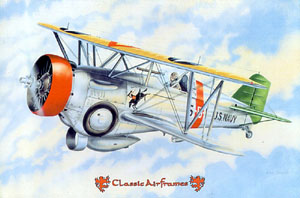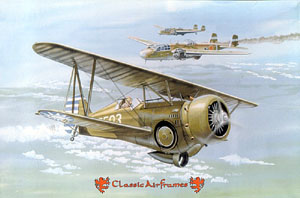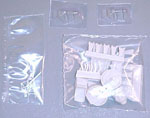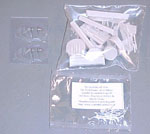


 Classic
Airframes 1/48 Curtiss BF2C-1
Classic
Airframes 1/48 Curtiss BF2C-1
& Curtiss Hawk III
By Michael Benolkin
Background
Curtiss had developed a strong reputation within the US military as well as with the allied nations for building robust aircraft. The BF2C was an outgrowth of the earlier fixed-gear BFC produced for the USN, incorporating the manually operated retractable landing gear found on the Grumman FF. Despite its advanced features, including the solid Wright Cyclone R-1820 engine of 700 hp, the BF2C was plagued with technical problems that led it to be withdrawn from service less than a year after its introduction.
 While
the USAAC was operating liquid-cooled engines in its Hawks, Curtiss decided
to build an export Hawk based on the BF2C airframe. One of the major problems
that had plagued the BF2C was vibration from the Cyclone engine. Curtiss
solved the problem in the Hawk III with a revised wing structure. Other
changed included a three-bladed propeller (the BF2C used a two-bladed
prop), deletion of the tailhook, a new cowl, and other cosmetic revisions.
The resulting aircraft saw service with China against the Japanese invasion,
with Thailand against the French (and later Japan), and Argentina.
While
the USAAC was operating liquid-cooled engines in its Hawks, Curtiss decided
to build an export Hawk based on the BF2C airframe. One of the major problems
that had plagued the BF2C was vibration from the Cyclone engine. Curtiss
solved the problem in the Hawk III with a revised wing structure. Other
changed included a three-bladed propeller (the BF2C used a two-bladed
prop), deletion of the tailhook, a new cowl, and other cosmetic revisions.
The resulting aircraft saw service with China against the Japanese invasion,
with Thailand against the French (and later Japan), and Argentina.
The KitsClassic Airframes continues to fill significant voids in aircraft lineage in 1/48 scale. These latest two releases, the BF2C-1 and Hawk III, contribute to the lineup of pre-WWII combat aircraft.Both kits are molded in light grey plastic, with resin details (including the engine) and white metal parts. Two vac canopies are also included in each kit, one to use and a spare in case of accident.Another manufacturer might have made these kits identical with only the decals to distinguish the difference. Not so with Classic Airframes! The tree containing the wings and tail surfaces are identical between the two kits (as they were in real life, the differences were internal). The tree containing the fuselage details are similar between the two kits, but there are differences. The fuselage and bulkheads are the same, but the cowls, aft fuselage and propellers are different. A nice piece of mold-making here. |
As with any limited production kit, the plastic will require a little fitting and trimming to get a smooth fit, but the work will be minimal. There are no ejector pin marks on any visible parts of the kit, and there is very little flash. All of the details are finely scribed, while the wings and tail surfaces are nicely molded to represent fabric over rib structures.
The resin parts are common between the two kits, with beautifully molded cylinders, exhaust manifolds, and core structure for the Cyclone engine, detailed wheel wells, and cockpit interior. The casting is intricate and free of flash, bubbles and other annoyances.
The white metal parts comprise the retractable landing gear struts and mechanism as well as the fixed tailwheel. The casting work on these parts is equally as nice as the resin.
Another nice touch in these kits is the inclusion of a color profile for painting and placement of decals. This solves the ambiguities that even the aftermarket decal makers sometimes confront us with, trying to represent colors and markings in shades of grey, then copying these instructions for production. The results are sometimes frustrating!
The BF2C has markings for two machines from VB-5B aboard the USS Ranger. This was the only unit to operate the BF2C before its withdrawal from service. With a little homework (or referring to the guide we produced for marking early USN fighters in the F3F-1 article a few months ago), you can represent any of the VB-5B aircraft.
The Hawk III kit provides markings for a Chinese Air Force machine as it appeared in 1937, or a Royal Thai Air Force machine circa 1940/41.
Conclusion
These kits will look great next to the other between-the-wars biplanes that Classic Airframes has produced as well as with the F3Fs currently available from Accurate Miniatures. If you are a 1/48 scale post-WW1 biplane builder, this is a great time for you! If not, you might want to give one of these kits a try for a change of pace – you might become a convert! My sincere thanks to Classic Airframes for these review samples.

Previous: Contents














